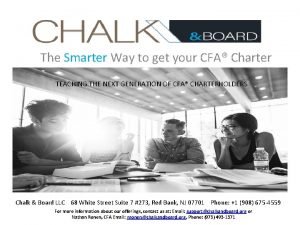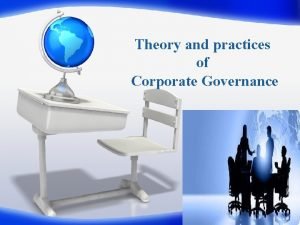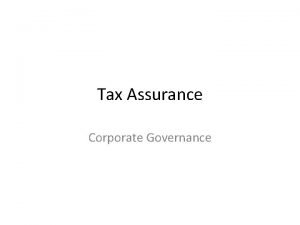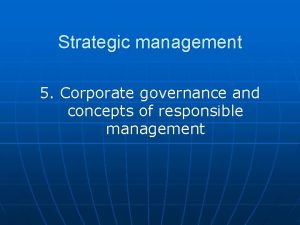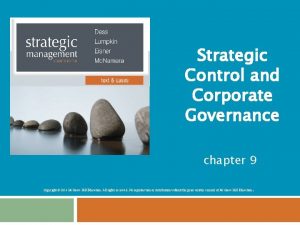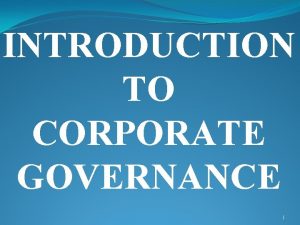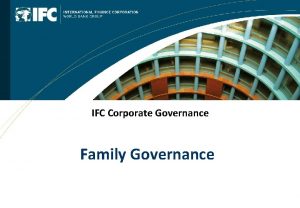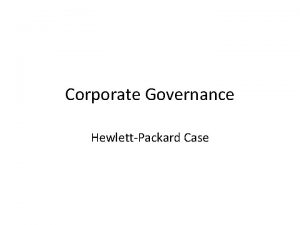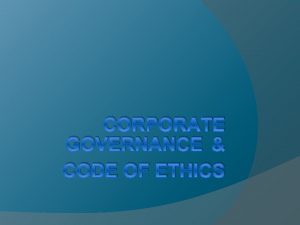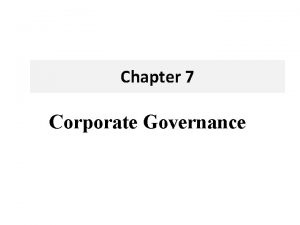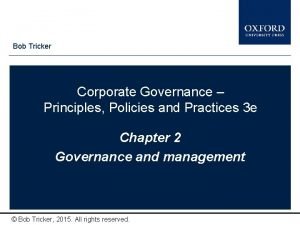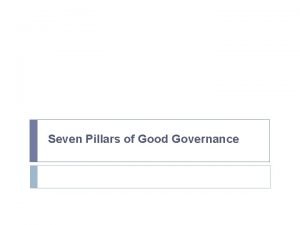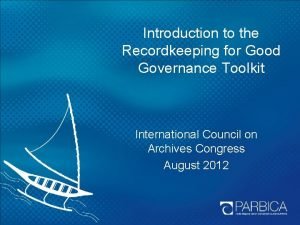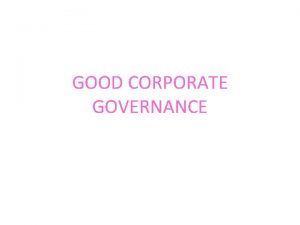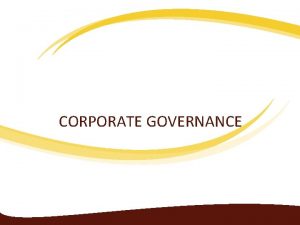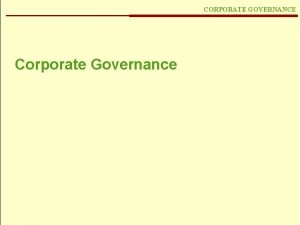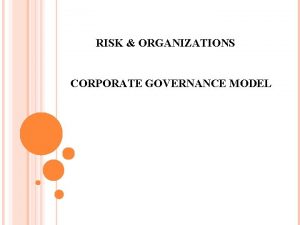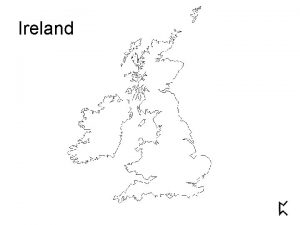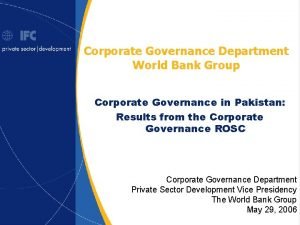Corporate Governance Review 2010 CFA Ireland presentation 20





















- Slides: 21

Corporate Governance Review 2010 CFA Ireland presentation 20 April 2010 Paul Raleigh Managing Partner Cian Blackwell Partner, Business Risk Services

Agenda • • What is the Corporate Governance Review? What is corporate governance? What are corporate governance "regulatory frameworks"? What is the regulatory framework for listed companies? What areas have we focused on in our commentary? What areas does it cover and what are the findings? Questions and answers

What is the Corporate Governance Review? • Origins – Grant Thornton Ireland Combined Code review 2007 • all ISE Main Market companies – Similar reviews done by Grant Thornton in several other countries— UK, Australia, Greece, Hong Kong. • now in its fourth year – significant publicity last year, at launch and into this year – recognised by journalists and commentators as a significant publication on this topic – designed to generate debate • panel debate hosted subsequent to launch

Population of companies • includes 36 companies (2009: 39 companies) – all companies listed on the Main Market of ISE – small cap companies (e. g. Aminex, Datalex) – companies with a primary listing in the UK (e. g. Diageo, Tesco)— obliged to comply with the Code – Anglo Irish Bank—still listed at the time of its most recent annual report, 30 September 2008 – several companies with large state shareholdings • excludes companies with a primary listing outside Ireland the UK (e. g. Aryzta)—no Combined Code obligations

What is corporate governance? A few definitions: • Corporate governance is "a set of relationships between a company's board, its shareholders and other stakeholders. It also provides the structure through which the objectives of the company are set, and the means of obtaining those objectives, and monitoring performance, are determined. " (OECD, 1999) • "Corporate governance is concerned with holding the balance between economic and social goals and between individuals and communal goals…the aim is to align as nearly as possible the interests of individuals, corporations and society. " (Sir Adrian Cadbury, 1999) • "Corporate governance deals with the ways in which suppliers of finance to corporations assure themselves of getting a return on their investment. " (Shleifer and Vishny, 1997)

The key relationships in corporate governance • shareholders provide resources to the company, via the board and management • shareholders expect to receive: – a return on investment – assurance that the ROI is being maximised

How shareholders gain assurance • • • board level structures are put in place to ensure it is an effective supervisor of management board and management identify risks to the achievement of the organisation's goals controls are put in place to mitigate those risks reporting is provided to inform shareholders auditing (internal and external) is performed to ensure that the controls are operating and the risks are being mitigated

What are corporate governance "regulatory framework"? • every organisation has a regulatory framework • includes both "hard law" and "soft law" – Companies Acts and other legislation – EU Regulations and Directives – Contractual obligations, e. g. ISE Listing Rules – Guidelines and best practice • FRC's Combined Code on Corporate Governance • OECD Guidelines on Corporate Governance • Department of Finance Code of Practice for the Governance of State Bodies

What is the regulatory framework for listed companies? • fundamentally, must comply with the Companies Acts— the same as any other company • additionally, all companies listed on the ISE main market are required to comply with the Listing Rules – http: //www. ise. ie/index. asp? loc. ID=534&doc. ID=483 • Listing Rules include obligations relating to companies applying for listing, and continuing obligations for those already listed – includes obligation to make a statement that it complies with the Combined Code, or if not, to explain why • sanctions: censure (of companies or directors), suspension of shares, delisting

What areas does it cover, and what are the findings? (1) Combined Code compliance • covers whether companies are fully compliant, or whether they explain non-compliance • findings: – 36% of companies claim they are fully compliant • remainder explain their non-compliance • most companies are non-compliant with only a small number of requirements

What areas does it cover, and what are the findings? (2) Non-executive directors • covers independence, board balance, and appraisal – 23% of companies did not have a majority of independent NEDs for the full year – disclosure of independence is frequently poor • companies need to decide whether a director is independent or not • if they claim the director is independent, but certain criteria exist, the annual report needs to explain why • information is not easily found by shareholders

What areas does it cover, and what are the findings? (3) Board structure (i) • covers roles, meetings, division of responsibilities – board structure (including composition, independence, committee membership) is not clear from annual reports – clarity is needed; suggestion:

What areas does it cover, and what are the findings? (3) Board structure (ii) – 36% of companies don't disclose the terms and conditions of appointment of NEDs – 33% of companies don't disclose appropriate evaluation of chairman's performance – several companies fail to separate chair and chief executive • Grafton, Aminex and, post year end, AIB. • 28% of companies fail to state a clear division of responsibilities

What areas does it cover, and what are the findings? (4) Audit committee and auditors • covers membership of committee, financial experience, terms of reference, internal audit, external audit – only 44% of companies disclose that audit committee has recent and relevant financial expertise • stricter criteria this year (justifiably) – 23% of companies don't disclose the existence of an internal audit function – levels of detail in breakdown of non-audit services vary widely • only 14% provide details of both type and value of non-audit services – change of auditors happens rarely

What areas does it cover, and what are the findings? (5) Remuneration committee • covers composition of committee, disclosure of remuneration (basis of remuneration, performance-related elements, quality of disclosures) – 19% of companies do not have a compliant remuneration committee • requires at least three members, all independent – disclosure of performance-related elements of remuneration is still poor • 34% do not comply with the requirement for performance-related elements to be a "significant proportion of the total remuneration package"

What areas does it cover, and what are the findings? (6) Nomination committee • covers composition and operation of the committee – 23% of companies have a non-compliant nomination committee • requires a majority of independent NEDs

What areas does it cover, and what are the findings? (7) Internal control and risk management • covers review of controls, managing risk, disclosure of detail – compliance with internal control recommendations from the Turnbull guidance is not high • 61% do not adequately disclose control weaknesses

What areas have we focused on in our commentary? (1) • regulatory framework – much of the regulatory framework is "optional" – lack of sanctions and enforcement – multiple regulators, but none providing sufficient enforcement of regulation • board structure and organisation – independence – skills and expertise of directors need focus

What areas have we focused on in our commentary? (2) • role of the chairman – strong chair is vital to a successful board – chair responsible for structure, composition, balance, organisation, resourcing and operation of board – still not clearly understood by many • risk and control – risk management and internal control not adequately understood at board level – companies not doing, or disclosing, enough to give shareholders assurance

What are the benefits of good corporate governance? • report provides: – an indicator of relative performance – suggestions for how to improve compliance and disclosure – a benchmark for companies not listed on the Main Market • research links good governance with good performance • good governance: – provides assurance to the board, and to shareholders • Gives them the information they need to invest and stay invested – aligns strategy, risk and control – allows companies to differentiate themselves from competitors

Paul Raleigh, Managing Partner paul. raleigh@grantthornton. ie +353 (0)1 6805805 Cian Blackwell, Partner, Business Risk Services cian. blackwell@grantthornton. ie +353 (0)1 6805710
 Objectives of corporate governance
Objectives of corporate governance Nathan ronen
Nathan ronen Sociological theory in corporate governance
Sociological theory in corporate governance Definitie corporate governance
Definitie corporate governance What is ownership
What is ownership Role of corporate governance in strategy formulation
Role of corporate governance in strategy formulation Isu dan riset kontemporer corporate governance
Isu dan riset kontemporer corporate governance What is corporate governance
What is corporate governance Family governance definition
Family governance definition Corporate governance in sri lanka
Corporate governance in sri lanka Mbhni hgwpi
Mbhni hgwpi Hp corporate governance
Hp corporate governance P&g code of conduct
P&g code of conduct Defination of corporate governance
Defination of corporate governance Staggered board structure
Staggered board structure Tricker model of corporate governance
Tricker model of corporate governance Two approaches in corporate governance
Two approaches in corporate governance Five pillars of good governance
Five pillars of good governance Corporate governance is a form of
Corporate governance is a form of Corporate governance tool kit
Corporate governance tool kit Corporate social responsibility and good governance
Corporate social responsibility and good governance Latar belakang munculnya gcg di indonesia
Latar belakang munculnya gcg di indonesia

